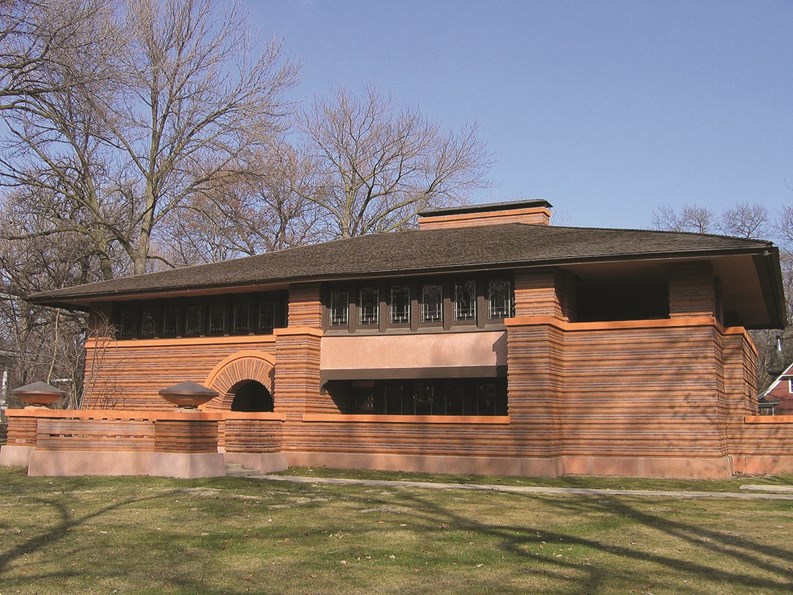Renowned architect Frank Lloyd Wright built a home and studio here, Ernest Hemingway learned to write the great American novel here and Edgar Rice Burroughs’ Tarzan mused about swinging from tree limb to tree limb, all in the village of Oak Park, Illinois.
While many writers, sports figures, journalists, actors and comedians have also made their homes in Oak Park, (too many to count) among the more famous names you come across are television actress and comedian Betty White and McDonald’s founder Ray Kroc, who were both born in Oak Park. And it was also the home turf of mafia crime boss Sam Giancana, who was murdered by an associate in 1975 in the kitchen of his village house. Dan Castellaneta, the voice of animated character Homer Simpson, is an Oak Parker as well.
Oak Park, which has a population as of the 2010 U.S. Census of 51,878, is the 29th largest municipality in Illinois, and is located on Chicago’s West Side. Just 10 miles west of downtown Chicago, the village offers many services attractive to both families and business leaders.
Rapid Growth
The village was settled in the early 1830s and it grew rapidly thanks to the influx of railroads and street cars connecting it to neighboring suburbs and jobs in nearby Chicago. Oak Park was incorporated in 1902, when it broke off from Cicero, Illinois.
In 1835, Joseph and Betty Kettlestrings, immigrants from Yorkshire, England, purchased 172 acres of land just west of Chicago and built a small frame house that they soon turned into a tavern, according to a historical account by the Historical Society of Oak Park & River Forest. They charged patrons 50 cents for supper, bed and breakfast. Once their children were born, they moved to Chicago to raise them and send them to school and rented out their farmhouse. They moved back again in 1855 to build a more substantial home near Scoville and Lake Streets. The home continued in that location until 1935 when it was razed to build a high school.
More farmers and settlers had entered the area and the Kettlestrings sold off parcels of their land holdings to people, who had come there via the Galena and Chicago Union Railroad, which opened the area to travel in 1848. Their land was called by several names locally, including Oak Ridge. When the first post office was set up, it could not use the name Oak Ridge as another post office was using that name in Illinois, so the post office chose Oak Park. The name stuck and became the name for the growing settlement and for the town when it incorporated in 1902.
The Chicago Fire
By 1850, the railroad had been constructed as far as Elgin, Illinois, and passed through the Oak Park settlement area. The Great Chicago Fire in 1871, according to the historical society, created a boom in development as Chicago residents left the city to build in the suburbs. The population (500) at the time of the fire ballooned to 4,589 in 1890. Religious organizations had built so many new churches for the newfound population, Oak Park became known as “Saints’ Rest.”
The emergence of the railroad helped further the population spike. The area grew to 9,353 in 1900, to 20,911 in 1910, to 39,585 in 1920.
It was also around this time that the village took an alcohol prohibition stance. In 1872, Illinois legislator Henry Austin created and passed the Illinois Temperance Act, which effectively banned the sale of alcohol within the village borders. Oak Park remained dry for the next 100 years. It wasn’t up until 2002 that select grocery stores were given permission to sell packaged liquor.
Frank Lloyd Wright’s Influence
In 1889, architect Frank Lloyd Wright and his wife settled in Oak Park. He built many homes and the Unity Temple, his own church, in the village, before he left in 1911 to settle in Wisconsin. So it’s not surprising that Oak Park today attracts many architecture buffs and others to view the many Frank Lloyd Wright-designed homes found in the village, amid homes reflecting other architectural styles. In fact, the largest collection of Wright-designed residential properties in the world is in Oak Park.
The village has other attractions as well. One can visit Ernest Hemingway's birthplace home and his boyhood home, the Ernest Hemingway Museum, the three Oak Park homes of writer and Tarzan creator Edgar Rice Burroughs, Wright's Unity Temple, Pleasant Home, and the Oak Park-River Forest Historical Society. Historical preservation is important, as villagers maintain three historic districts, and three styles of architecture: Queen Anne, Prairie School and Craftsman.
During the 1880s, housing construction flourished, and up until 1950, most of the village’s buildings were built. During the 1920’s, Chicago’s large department stores, like Marshall Fields and The Fair Store, built branches on Lake Street. By 1930, the population had burgeoned to 64,000, much larger than today.
The village continued to prosper, and in 1976, the village was designated an “All-American City,” a model that it follows today. It is also a perennial Tree City USA with dozens of restaurants and 12 distinct shopping districts.
Oak Park has an active arts community, likely due to its proximity to Chicago. It hosts several professional dance and theatre companies, including Circle Theater, Oak Park Festival Theatre and Momenta. The Oak Park Art League (OPAL) also runs varied programming throughout the year. The Oak Park Conservatory is also a botanical gem with tropical and desert greenhouses on-site. Tours are offered privately but the nature center is open Tuesdays through Sundays. Free admission with a voluntary donation. The Brookfield Zoo is also close by.
In 2014, a record 107 million visitors came to Illinois, and Oak Park features many attractions from museums to shopping and dining that will continue to draw tourists and potential new residents.
If you’re looking for a nice, livable community that drew the likes of Frank Lloyd Wright to set up stakes, look no further than Oak Park, Illinois.
Debra A. Estock is managing editor of The Chicagoland Cooperator.





Leave a Comment